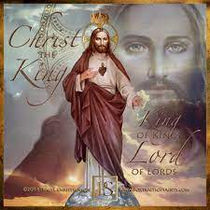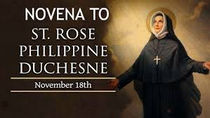The Catholic Defender: Two Eucharistic Miracles from Belgium
- Donald Hartley

- Jul 17, 2023
- 5 min read

ST. AUGUSTINE
"You ought to know what you have received, what you are going to receive, and what you ought to receive daily. That Bread which you see on the altar, having been sanctified by the word of God, is the Body of Christ. The chalice, or rather, what is in that chalice, having been sanctified by the word of God, is the Blood of Christ."
-"Sermons", [227, 21]
"He who made you men, for your sakes was Himself made man; to ensure your adoption as many sons into an everlasting inheritance, the blood of the Only-Begotten has been shed for you. If in your own reckoning you have held yourselves cheap because of your earthly frailty, now assess yourselves by the price paid for you; meditate, as you should, upon what you eat, what you drink, to what you answer 'Amen'".
-"Second Discourse on Psalm 32". Ch. 4. circa
"For the whole Church observes this practice which was handed down by the Fathers: that it prayers for those who have died in the communion of the Body and Blood of Christ, when they are commemorated in their own place in the sacrifice itself; and the sacrifice is offered also in memory of them on their behalf.
Source: St. Augustine, Sermons 172,2, circa 400 A.D.
"The fact that our fathers of old offered sacrifices with beasts for victims, which the present-day people of God read about but do not do, is to be understood in no way but this: that those things signified the things that we do in order to draw near to God and to recommend to our neighbor the same purpose. A visible sacrifice, therefore, is the sacrament, that is to say, the sacred sign, of an invisible sacrifice… . Christ is both the Priest, offering Himself, and Himself the Victim. He willed that the sacramental sign of this should be the daily sacrifice of the Church, who, since the Church is His body and He the Head, learns to offer herself through Him. Source: St. Augustine, The City of God,

Eucharistic Miracle of Bruges, Belgium
The oldest documents concerning the Holy Blood of Bruges date back to 1256. The Holy Blood probably was part of a group of relics of the Passion of Christ preserved at the Imperial Museum of Bucoleon in Constantinople (modern Istanbul).
In 1203 Constantinople was besieged and conquered by the crusaders. Baldovin IX, Count of Flanders, after being crowned as the new emperor, sent the relic of the Precious Blood to his native country at Bruges.
Recent analyses were made on the crystal bottle containing the Holy Blood. The bottle has been dated as of the 11th century. It is also sure it was made in an area near by Constantinople.
Although in the Bible there is no explicit mention that the Blood of Christ was ever preserved, in one of the Apocryphal Gospels it is narrated that Joseph of Arimathea preserved some drops of the Blood of Christ.
According to an ancient tradition, Count Diederik van den Elzas brought the bottle containing the Blood of Christ from Jerusalem to Bruges during the second crusade. Recent investigations however have pointed out that the relic arrived in Bruges at a later date, probably around 1250 coming from Constantinople.
The veneration of the relic is at the origin of the internationally famous procession that is held every year through the streets of the city on the day of the Feast of the Ascension. The citizens of Bruges dress in historical customs and reenact biblical scenes and the arrival of the Count of Flanders who brought the holy relic.

Eucharistic Miracle of Brussels, Belgium
In the Cathedral of Brussels there are many artistic testimonies to a Eucharistic miracle verified in 1370. Desecrators stole Hosts and struck at them with knives as a way of showing their rebellion. From these particles came a flow of living blood.
This miracle was celebrated up until some decades ago. There are many reliquaries of different eras that were used to contain the miraculous Hosts of the miracle of the Blessed Sacrament. They have been kept to this day in the museum close to the cathedral in an ancient chapel of the Blessed Sacrament. There are tapestries of the 18th century which represent the miraculous event.
The five stained glass windows that grace the side nave of the cathedral take us through stages of the Eucharistic miracle. They were installed at various times from 1436 to 1870. The Kings of Belgium, Leopold I and Leopold II, presented the first windows on the lower level. The others were gifts from various noble families of the country. The first ten windows represent the story as it came to Brussels in the middle of the 15th century.
The ancient document reads : “In 1369 a rich merchant from Enghien who hated the Catholic religion, had some consecrated Hosts stolen. He worked with a young man from Louvain (on windows 1-3). The merchant was assassinated mysteriously a few days later. His widow, surmising it was a punishment from Heaven, got rid of the Hosts by giving them to friends of her husband.

These friends were filled with hatred of things Catholic. “On Good Friday 1370, the friends met and began to slash the Hosts with knives, and the Hosts began to bleed! The desecrators were badly frightened and entrusted the Hosts to an important Catholic merchant.
“This merchant revealed the whole story to the curate of the Church of Notre Dame. The curate took possession of the Hosts and the desecrators were condemned to death by the Duke of Brabant. The Hosts were taken in procession to the cathedral of St. Gudula”. The Eucharistic miracle remains an important part of the traditions of Brussels and is something of a national symbol.
"You know that you were ransomed from the futile ways inherited from your fathers, not with perishable things such as silver or gold, but with the precious blood of Christ, like that of a lamb without blemish or spot." 1 Peter 1:18-19
Bonus Coverage
Eucharistic Miracle of Douai, France, 1254
In the Eucharistic miracle of Douai, a consecrated Host was unintentionally dropped to the ground while a priest was distributing Communion to the faithful. Immediately he bent down to pick up the Holy Eucharist, but the Host lifted up in flight and lighted on the purificator.
A little later, a wonderful Child appeared there, Who all the faithful and religious present in the celebration could contemplate.
Although more than 800 years have elapsed, even today it is still possible to admire the Host of the miracle. All Thursdays of the month in the Church of Saint Peter of Douai, many faithful gather in prayer before the miraculous Host.
Bonum universale de Apibus is the work written by an eye witness of the miracle: the Dominican Father Thomas de Cantimpré, doctor of theology and “suffragan” Bishop of Cambrai.
On the day of Easter in 1254 in the Church of St. Amato in Douai, a priest who was distributing Holy Communion unintentionally dropped a consecrated Host to the ground. Immediately he bent down to pick up the Sacred Species, but the Host lifted up in flight and lighted on the purificator. A little later, a wonderful Child appeared there Who all the faithful and religious present in the celebration could contemplate.





















Comments